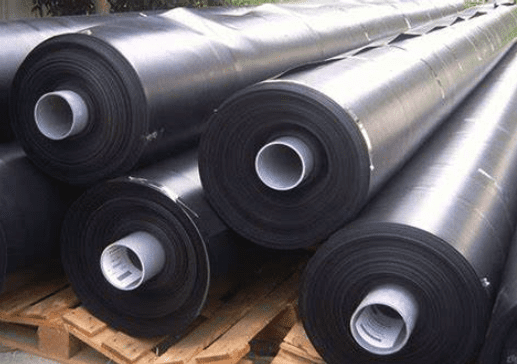Introduction
Waterproofing and environmental protection play a crucial role in modern construction and civil engineering projects. Among the wide range of materials available, HDPE geomembrane liners have emerged as one of the most reliable and durable solutions. These liners offer excellent protection against fluid leakage and environmental contamination.
Whether you’re building a landfill, reservoir, mining containment pond, or industrial wastewater lagoon, HDPE geomembranes provide unmatched performance and longevity. In this comprehensive guide, we’ll explain what HDPE geomembranes are, highlight their key benefits, and explore their wide-ranging applications. Furthermore, we’ll show you why more engineers and contractors are choosing HDPE liners over other materials.
What Is HDPE Geomembrane?
HDPE (High-Density Polyethylene) geomembrane is a synthetic material created from thermoplastic polymer. It is highly regarded for its superior strength, durability, and resistance to a variety of environmental factors. Engineers typically use HDPE geomembranes to provide long-lasting, reliable protection against contamination caused by liquids or gases.
Unlike natural materials, HDPE is engineered to resist damage from harsh chemicals, UV radiation, and physical stress. This makes it the ideal choice for containment projects in both industrial and environmental applications. The geomembranes are manufactured using extrusion or blown film processes, ensuring consistent thickness and quality.
Typically, HDPE geomembranes come in black to provide maximum UV resistance. However, they are also available in white, green, or even textured varieties, depending on the specific project requirements. Regardless of the color, HDPE geomembranes maintain their excellent performance and protective qualities.
Why Use HDPE Geomembrane?
HDPE geomembrane liners are used to prevent the migration of fluids or gases from one area to another. Because of their impermeability, they are ideal for:
Preventing water seepage in reservoirs or canals
Lining landfills to prevent leachate escape
Containing chemicals in industrial facilities
Creating a stable aquatic environment in fish or shrimp farms
In short, if your project involves retaining or isolating liquids, HDPE liners are a practical and efficient solution.
Key Benefits of HDPE Geomembrane
Let’s take a closer look at the main advantages of using HDPE geomembranes in construction and environmental projects.
1. Outstanding Chemical Resistance
HDPE is inert to a wide variety of aggressive chemicals, including acids, alkalis, and hydrocarbons. As a result, it is an excellent choice for chemical containment applications such as tailing ponds or wastewater lagoons.
2. Superior UV and Weather Resistance
Thanks to its carbon black content and strong molecular structure, HDPE performs exceptionally well under prolonged sunlight exposure. Even in extreme climates, the material resists cracking, brittleness, and premature aging.
3. Low Permeability
One of the most important characteristics of HDPE geomembrane is its extremely low permeability. Therefore, it effectively prevents seepage and contamination, protecting groundwater and surrounding ecosystems.
4. Cost-Effective Over the Long Term
Although HDPE liners may have a higher initial cost than alternatives like PVC or LDPE, their long service life and low maintenance requirements provide substantial savings in the long run.
5. Strong and Flexible
HDPE geomembranes combine high tensile strength with excellent flexibility. This means they can be deployed across uneven terrain and withstand ground movements without tearing or puncturing.
6. Environmentally Friendly
HDPE is recyclable and does not release toxic fumes during installation. Consequently, it is considered safe for use in environmentally sensitive projects.
Typical Technical Specifications
| Property | Value Range |
|---|---|
| Thickness | 0.5 mm – 3.0 mm |
| Density | 0.94 – 0.96 g/cm³ |
| Tensile Strength | ≥ 20 MPa |
| Elongation at Break | ≥ 700% |
| Water Vapor Permeability | < 1.0 × 10⁻¹³ g·cm/(cm²·s·Pa) |
| Operating Temperature | -50°C to +85°C |
| Carbon Black Content | 2% – 3% |
| UV Resistance | Excellent |
It is important to choose the correct thickness and grade based on your application. If you’re unsure, feel free to contact our technical team for guidance.
Common Applications of HDPE Geomembrane
HDPE geomembrane is a versatile material used in a wide range of industries. Let’s review some of its most common uses:
✅ Landfills
HDPE liners are extensively used in municipal and hazardous waste landfills. They serve as base liners and cover systems, effectively preventing the leakage of leachate into the soil and groundwater.
✅ Mining
In mining operations, HDPE geomembranes are used in heap leach pads, tailings storage, and evaporation ponds. Because they resist harsh chemicals, they’re ideal for containing leaching solutions and mining waste.
✅ Water Reservoirs and Canals
HDPE liners help conserve water by eliminating seepage in irrigation canals, agricultural ponds, and municipal reservoirs. In dry regions, this benefit is particularly valuable.
✅ Aquaculture and Fish Farming
In aquaculture, HDPE liners are used to line ponds for fish and shrimp. Their smooth surface makes cleaning easy, and their non-toxicity ensures a healthy aquatic environment.
✅ Wastewater Treatment Facilities
Industrial and municipal wastewater treatment plants rely on HDPE geomembranes to line lagoons, aeration ponds, and sludge drying beds. This prevents contamination of soil and groundwater.
HDPE vs Other Geomembranes
You might wonder how HDPE compares with other materials like PVC, EPDM, or LDPE. Here’s a quick comparison:
| Feature | HDPE | LDPE | PVC | EPDM |
|---|---|---|---|---|
| Strength | Excellent | Good | Moderate | Moderate |
| Chemical Resistance | Excellent | Moderate | Moderate | Good |
| UV Resistance | Excellent | Poor | Good | Excellent |
| Flexibility | Moderate | Excellent | Excellent | Excellent |
| Lifespan | 25–35 years | 10–20 years | 15–25 years | 20–30 years |
| Installation Ease | Moderate | Easy | Easy | Easy |
In many cases, HDPE is the preferred choice due to its superior durability and environmental resistance.
Installation Guidelines
Installing HDPE geomembranes requires precision and care. Here’s an overview of the typical installation process:
1. Surface Preparation
The subgrade should be free of sharp rocks, vegetation, and debris. A geotextile layer may be added for extra protection.
2. Panel Deployment
The liner rolls are unrolled and laid out across the area. Installers must avoid dragging the sheets to prevent damage.
3. Seaming
Welding is typically done using hot wedge or hot air welding machines. Proper seam overlap and temperature are critical for strong joints.
4. Inspection and Testing
Seams are tested using vacuum box, air pressure, or spark testing to ensure leak-proof performance.
5. Anchoring and Protection
The edges of the liner are anchored in trenches or under weights. In some cases, a protective cover such as soil or concrete is added on top.
Internal Links and Resources
Want to learn more? Explore related pages on our website:
Why Choose Jingze Geosynthetics?
At Dezhou Jingze Geosynthetics, we specialize in high-performance geosynthetic materials. Here’s what sets us apart:
🌍 Export to Over 30 Countries
🔍 Strict Quality Control with ISO and CE Certifications
🚛 Fast Shipping and Custom Sizing
🧰 Full Installation Support & Technical Consultation
🛡️ UV-Resistant, Durable HDPE Products
Whether your project is large or small, we deliver premium solutions that meet international standards.
Conclusion
HDPE geomembrane is a powerful, versatile, and eco-friendly liner that meets the strict requirements of modern engineering. Its performance in terms of strength, chemical resistance, and UV durability makes it one of the best choices for long-term containment applications.
If you’re planning a project that involves fluid or waste containment, contact Jingze Geosynthetics for expert advice, premium materials, and competitive pricing. We’re here to help every step of the way.


